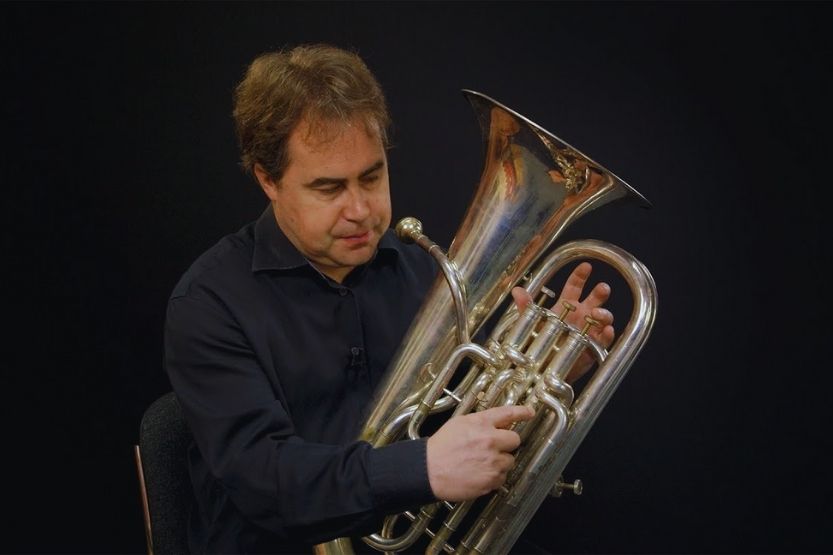Even some musicians and bandleaders assume that the euphonium and the baritone are the same. While there are many things similar between these two instruments, they are different. euphonium vs baritone – what are the differences?
The primary difference between the euphonium and the baritone is their bore shape and size. For the euphonium, the bore is conical, and the tubing gradually gets larger from its mouthpiece going to the bell. With the baritone, the bore is cylindrical, the size of which remains the same throughout its main body.
In general, baritones are smaller than euphoniums. The general shape of baritones is cylindrical, while euphoniums are more conical. But both brass instruments have a standard tuning that is set in the key of B-flat.
Read on to learn more about euphonium and baritone, their differences, as well as some of their similarities.
Also, we hope you find the links here useful. We may get a commission if you purchase something through a link on this page, so thank you!
Euphonium Vs Baritone – What Are the Differences?

At the surface, a euphonium and a baritone seem to be the same in size and shape. But when you look at them closely, you will notice their differences. Their biggest difference is their bore shape and size.
The euphonium’s bore is conical, and its tubing gradually grows in size from the mouthpiece to the bell. The baritone’s tubing is cylindrical, and its size is the same throughout its entire length.
In general, baritones are smaller than euphoniums. However, they are both set in the key of B-flat as their standard tuning. The euphonium has valves that are pitched one octave below the trumpet. In military bands, it is the leading brass instrument in the range of tenor-bass.
Baritones are shaped like euphoniums, and they also have the same pitch range. However, the euphonium’s sound quality is generally mellower because of its wider bore than the baritone. Meanwhile, the cylindrical shape of the bore of the baritone produces brighter sounds.
Why Are People Confused About Euphonium vs Baritone?
Click here to see this Mendini MEP-L Lacquer Brass B Flat Euphonium on Amazon.
Click here to see this Protec MARCHING BARITONE PRO PAC on Amazon.
Many band members and bandleaders are confused about these two instruments simply because they have some similarities. How are they similar to each other?
Similarities Between Euphonium and Baritone
Here are some of their similarities:
1. Both Are Brass Instruments
The euphonium and the baritone are both brass instruments. This means they are made of metal, mainly brass. They are also called wind instruments, meaning they produce sound when an instrumentalist blows wind into their mouthpieces. These instruments were both invented in the 1840s.
The euphonium and the baritone both belong to the low-range brass family. Their normal music sheet reading is set in bass clef. Both instruments look similar to a tuba. And they also have the same fingering styles.
So, it is no wonder that they are commonly referred to interchangeably. You need to understand one other thing about these two instruments: you can also play the other when you learn to play one.
2. Both Are Played in Brass Bands But Not in Orchestras
The primary reason why there are no orchestral pieces that have euphonium and baritone parts in them is that they are recently invented musical instruments. Both instruments were only invented in the 1840s.
So, the great composers who existed and wrote their musical masterpieces during the 18th and 19th centuries have no way of knowing that there are such instruments that they also need to write music pieces.
Once they were invented, they quickly became the favorite instruments of brass bands, specifically in England. Later, they also became popular for use in concert bands everywhere. Brass bands, as you know, consist of percussion and brass instruments only, and no stringed ones.
On the other hand, Concert bands have brass and percussion instruments with the addition of woodwind instruments. They usually play pop tunes, lighter music, and classical pieces composed for concert bands in concert venues. Both instruments are also used in military or marching bands.
In a typical brass band in the U.K., there are two baritones and two euphoniums. The instrumentalists that play them usually sit together and play the same parts. But because of the differences in their bell and bore size, you will hear distinct sounds from them.
The sound of the euphonium will usually be mellower than that of the baritone, whose sound is a bit brighter. But their sounds blend in the middle tonal range of the band.
3. Both Instruments Are Written as B-Flat Instruments in Treble Clef
When they were invented, music composers started writing music for both the euphonium and the baritone.
They often wrote specific music for the baritone as a downward extension of the Tenor Horn section. Meanwhile, the music for the euphonium was written as an upward extension of the Tuba (Bass) section. As such, both euphonium and baritone’s music was written in treble clef.
What Is a Euphonium?

Many people seldom hear anything about the euphonium, so they don’t know what it is. It is a medium-sized, tenor-voiced brass instrument that has a conical bore. Its name was taken from a Greek word that means “sweet-voiced” or “well-sounding.” Technically speaking, it is a piston-valve musical instrument.
Compared to the baritone, the euphonium’s bore and bell are bigger. The shape of its tubing is more conical than cylindrical. This means the tubing diameter gets bigger as it extends to the bell. This particular shape is the reason why it has a darker, mellower, and more powerful sound than the baritone.
These instruments can have three to four valves. When it has four valves, three of them are top action and are played by the player’s right fingers. The fourth valve is mid-way down on the right section of the instrument. It is played by the index finger of the left hand.
Click here to see this Mutec MHT302 Straight Mute for Euphonium on Amazon.
What Is a Baritone?
Many people know that a baritone is a type of male singing voice typically on the lower register of the voice range. They don’t know that it is also a type of brass instrument. A baritone, also called the baritone horn, is also a brass instrument in the low-pitch range.
This instrument belongs to the saxhorn family, a group of piston-valve brass instruments with deep cup-shaped mouthpieces and conical (opposed to cylindrical) bores. The sounds produced by any member of the saxhorn family can blend well with other brass instruments.
The bore and bell of a baritone are smaller than those of the euphonium. Its tubing is more cylindrical as opposed to conical. So its tubing has more or less the same diameter in the entirety of the tubing.
This straight tube shape produces sounds that are lighter and brighter. Most baritones have only three valves, but some have four. The wrapping of the horn of a baritone is tighter than in a euphonium. With a smaller bell, the baritone is more compact, easier to use and carry.
Euphonium vs Baritone-What’s the difference? Compared to a euphonium, a baritone has a smaller bore and bell. Plus, the baritone has an almost cylindrical tubing. As a result, it produces a lighter and brighter sound.
Differences Between the Euphonium and the Baritone
Click here to see this Mendini B Flat Baritone with Stainless Steel Pistons (Beginner) on Amazon.
While there are many similarities between the euphonium and the baritone, it is in their differences where we can appreciate their individual values in a band. What are these differences?
1. Sound Quality
You can understand this difference if you will listen to the sounds that these two instruments produce. They are both pitched or tuned in B flat, but they still produce quite different sounds. Instruments pitches in B flat usually play the harmony part of an ensemble, orchestra, or band.
While having the same pitch, the fuller sound comes from the euphonium. This is mainly due to the conical shape of its tubing. While it is used to harmonize, it can also be used to do melody, counter melody, or even a fifth part.
Another way of putting it is that the sound from a euphonium is rounded and softer than the baritone. The sound of the baritone is often described as brighter and has more presence.
2. Bore Size and Shape
The shape of the tubing of the euphonium is conical. Its tubing size gets bigger as it extends from the mouthpiece to the end of the bell. Meanwhile, the shape of the baritone tubing is cylindrical all the way through.
The size or diameter of this tubing from the mouthpiece to the bell is roughly the same. This is the main reason why it produces a brighter sound than euphonium. The larger bore size and conical shape of the euphonium is the primary reason for its darker and more powerful sound.
Here is a table that shows how different reference sources describe the differences in the bores of the Euphonium and the baritone:
| Reference | Euphonium | Baritone |
| New Harvard Dictionary of Music | Bigger bore that is tapered like a flugelhorn | Smaller bore that is tapered like a cornet |
| The New Grove Dictionary of Music and Musicians | Wide bore with warm, big tone; Tenor of tuba family; with a deep-cup mouthpiece; | Narrow bore |
| New Oxford Companion to Music | Wider bore and is called baritone in the USA | Narrower bore |
| International Cyclopedia of Music and Musicians | Bigger semi-conical bore; larger tone; with deep-cup mouthpiece and 3 to 5 valves | Smaller bore and tone; with semi-conical cup mouthpiece and three valves |
3. Different Tubing Shape
Both tubings of the baritone and euphonium are generally of the same length. This means the main difference in their shapes is in their widths. In a euphonium, the shape of the tubing is in the form of a cone.
Then it steadily gets wider as it goes to the top of the bell, which is considerably bigger than where it started at the mouthpiece. Meanwhile, the tubing of the baritone also widens as it extends to the bell. However, its main tubing (body) remains cylindrical.
4. Number of Valves
Many people assume that all baritones are limited to just three valves, while euphoniums always have four. This is true generally. However, this is not always true for all euphoniums and baritones.
There are euphoniums with four or even five valves, and there are baritones with four valves. So, while they may be different in this aspect, it is not a major difference.
5. Manner of Playing
Playing the euphonium is somewhat different from playing a baritone. A euphonium is slightly more challenging to play than a baritone. With its conical shape, its tubing requires you to have more lung power to play it and produce quality sounds decently.
You also need to be stronger if you want to play this instrument because it is slightly wider and heavier than the baritone. In other words, younger players will have a more difficult time playing the euphonium than a baritone.
Summary of the Differences Between the Euphonium and the Baritone

To make it easier for you to remember their differences, here is a table that summarizes what has been discussed in this article:
| Particulars | Euphonium | Baritone |
| Shape of Tubing | Conical | Cylindrical |
| Sound Quality | Darker, more mellow, larger | Brighter |
| Bore Size | Slightly larger | Slightly smaller |
| Weight | Heavier | Lighter |
| Number of Valves | 3 to 4 | 3 |
| Mouthpiece | Deeper cut | Standard cut |
Conclusion: Euphonium Vs Baritone – What are the Differences?
The biggest difference between the euphonium and the baritone is their bore shape and size. The euphonium’s bore is conical, and its tubing gradually gets steadily bigger from the mouthpiece to the bell. On the other hand, the baritone’s bore is cylindrical in shape, carried throughout its entire body.
The sound quality that they produce is also different. A euphonium produces darker and mellower sounds, while the baritone produces brighter sounds. That is mainly due to the shapes of their tubing.
Related reading:
Chaconne Vs Passacaglia – What Is the Difference Between Them?
Cello Vs Bass – What Are Their Differences?













![Read more about the article Easy Clarinet Songs [Top 10 Easiest]](https://musicalinstrumentpro.com/wp-content/uploads/2021/10/Easy-Clarinet-Songs-300x200.jpg)